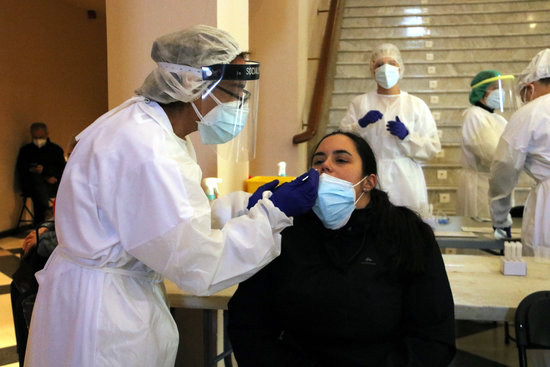Covid-19 transmission rate grows to levels that might not allow progressing in de-escalation
Health authorities plan to decide not moving to phase 2 next Monday as planned

It is now quite safe to say that the downward trend in the Covid-19 progression stopped a few days ago, as soon as the outbreak risk dropped from 'very high' to 'high' category on Monday.
Since then, the figures have begun to rise again, a week after bars, restaurants, cultural and sports venues began to reopen after roughly a month closed.
Because of that, authorities are planning to not move to de-escalation phase 2 as expected for next Monday. The issue was discussed in the civil protection emergency committee Procicat on Thursday morning.
On Thursday, the Covid-19 transmission rate, also known as the R number, increased for the fifth day in a row, reaching 0.92. If the R number goes above 1 that is an indication that every positive case, on average is spreading the virus to more than one person.
When Catalonia's government presented the progressive reopening scheme after the peak of the second wave last month, they said that if the transmission rate surpassed 0.90, the country would not move to phase 2.
The scheme provided four phases, and every two weeks there would be a phase progression – if the pandemic situation allowed it.
The plan came into force on Monday, November 23, so a decision on whether two weeks later, December 7, Catalonia will be in phase 2, is expected shortly.
Indeed, on Thursday at 1pm, the health minister, Alba Vergés, among other health and civil protection authorities will appear in a press conference, where their final decision on the issue is expected to be announced.
Phase two main measures
Phase two of the de-escalation plan would mean loosening the weekend partial lockdown – instead of having to stay in one's town of residence, the public would be allowed to travel within their county from Friday at 6am to Monday at 6am.
The closure of Catalan borders would still be in operation all days, while shops would see their capacity limit raised from 30% to 50% – shopping malls would open for the first time in over a month with a 30% capacity.
Cinemas, theaters, and music venues would be able to open at 70% and not 50% like in phase one, but the 500-people cap would stay – something that has sparked outrage of large venues such as the iconic Liceu opera house.
As for bars, they would see their capacity indoors from 30% to 50%, while outdoors the lack of limitation would continue – their opening times would stay from 6 am to 9:30 pm, as the 10pm to 6am curfew would still be in operation.
Several sectors are looking forward to moving phase, especially ski resorts, who announced earlier this week that they would open on December 9 if Catalonia moved to phase 2 next Monday.
Long weekend and Christmas
In their press conference on Thursday, authorities are expected to request maximum caution to residents for the coming days. The bank holiday next Tuesday might prompt a four-day long weekend for many, and health officials fear a worsening of the pandemic as a result.
On Wednesday, the Catalan government laid out the restrictions expected to be in place during the Christmas holiday.
The night curfew will be delayed until 1.30 am on December 24 and 31, and until 11 pm on January 5, the eve of the Three Kings Day.